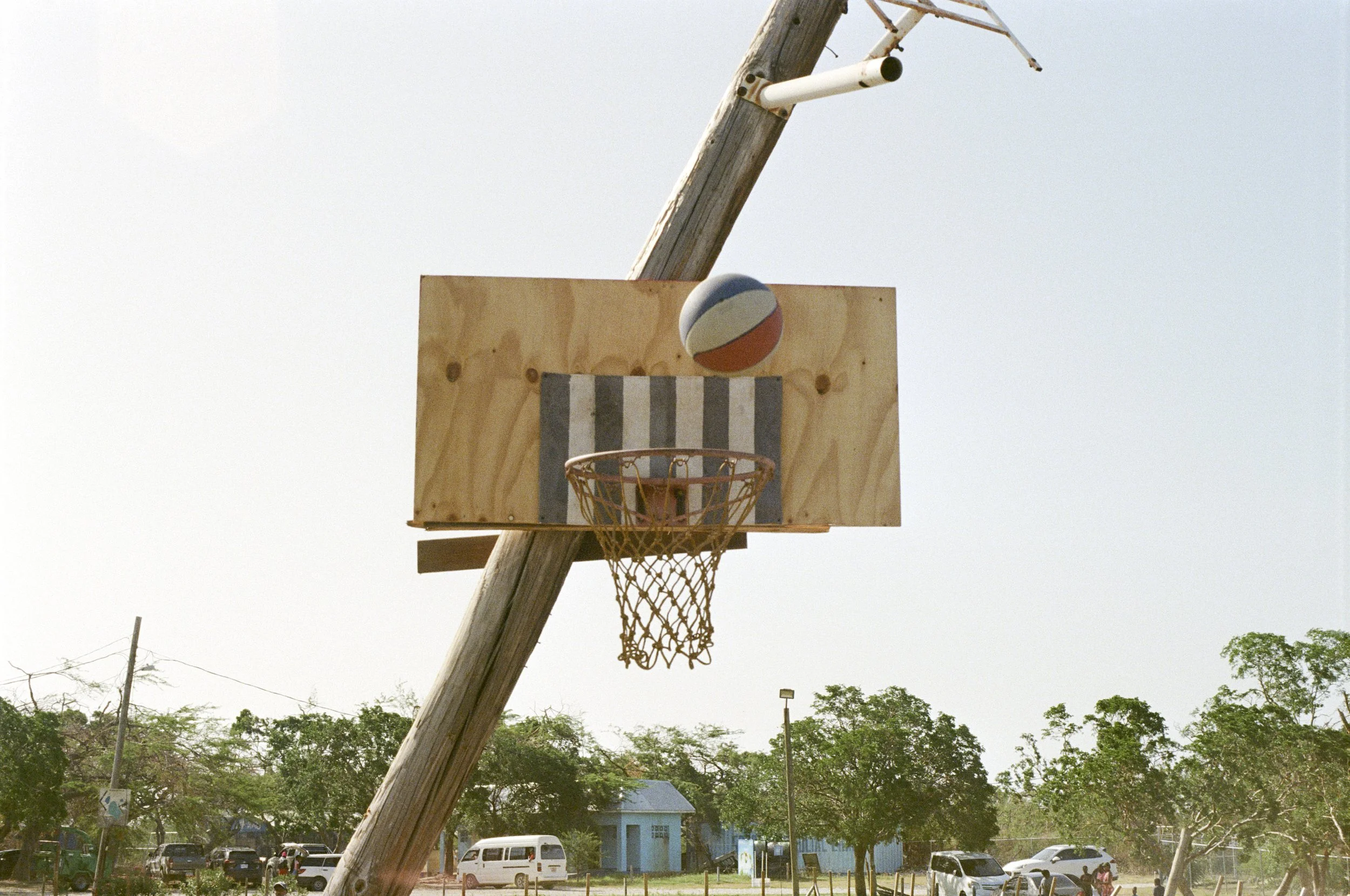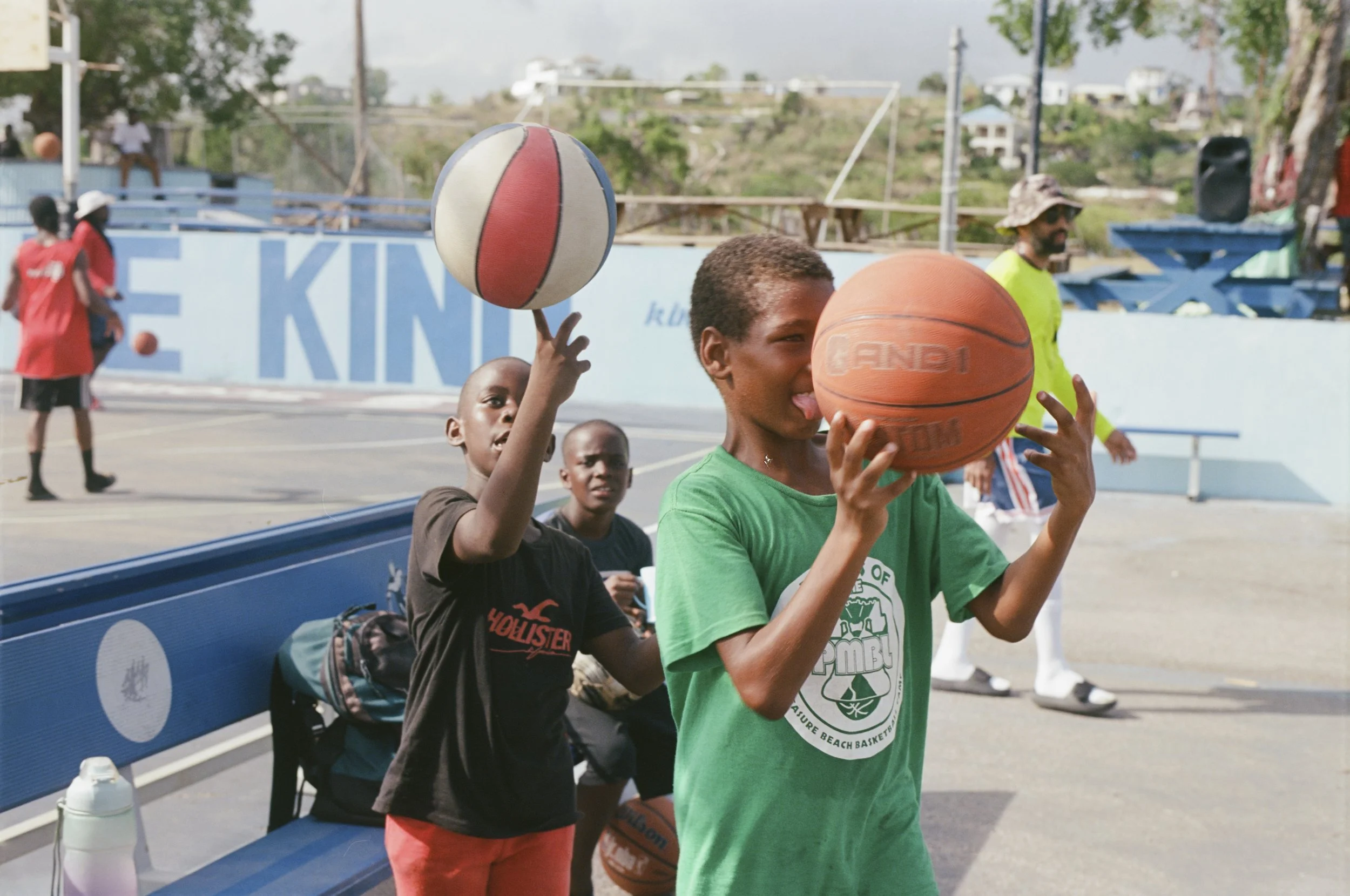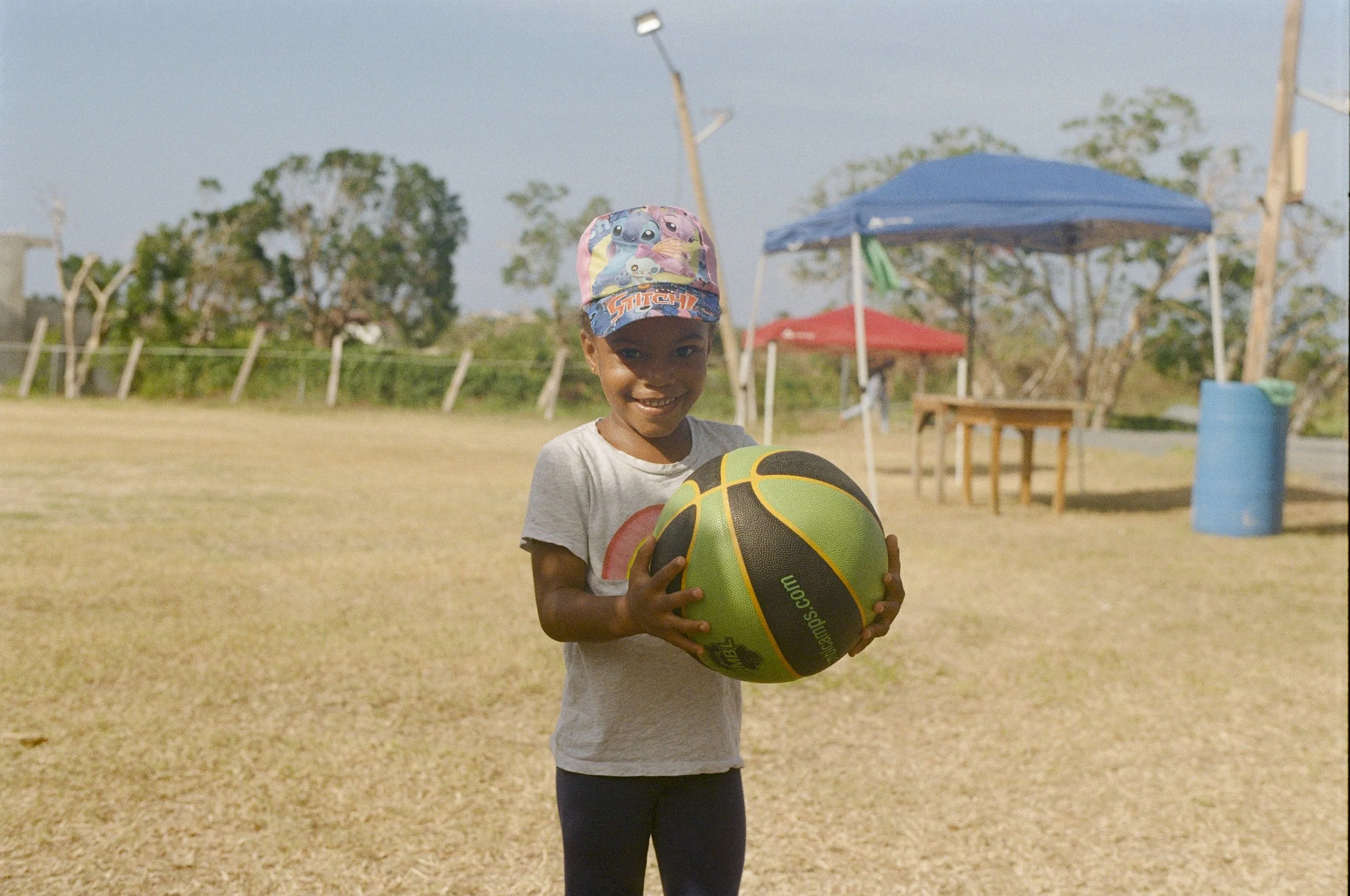Wah gwaan, coach? It’s the second day of basketball camp in Jamaica. A group of teenagers are teaching me patois instead of participating in the yoga station—two details that separate this camp from any basketball camp I’ve worked in the States. The Friends of the PMBL Basketball Camp in Treasure Beach, Jamaica is potentially unmatched in the basketball camp circuit, largely due to its values and priorities, which include building community, being loving to your friends, ensuring camp is free to every kid, and that those kids leave with new shoes and a backpack full of clothing and hygiene products. Additionally, everyday a group of village women make free breakfast and lunch for the campers in a hut with an open fire grill on the grounds. In my experience, these values and priorities simply don’t enter the equation in most basketball camps—even though they should. Their enormous impact is magnified in strategically undervalued countries trying to recover from a history of slavery and colonialism. This year, Friends of PMBL proved its unique abilities further by pivoting into a camp-slash-disaster relief team after Hurricane Beryl swept through Treasure Beach.
The Friends of the PMBL Basketball Camp began in 2013. Four friends with ties to Philly started a non-profit camp based off the Philadelphia Man’s Basketball League (PMBL) and partnered with the Breds Treasure Beach Sports Park in a small coastal village in the Saint Elizabeth parish of Jamaica. It’s as random as it sounds. The first day of the first year of camp 35 kids attended purely based on word-of-mouth. The coaches gave those kids shirts and shoes. By the afternoon session those kids had told their friends and 50 more came. By the final day they totaled 225 campers.
Now, bus loads of kids arrive from neighboring parishes. A coach from Kingston brings his team. Last year over 2,000 kids island-wide attended camp. Like many camps, the programming is dissected into rotating stations to teach basketball fundamentals through drills. Unlike most basketball camps, those stations include yoga, meditation, and self defense training. PMBL’s holistic approach hopes to add computer literacy and trade skills to the programming.
Campers who came as children have become coaches. Those local coaches are invaluable to the success and community trust, as the majority of PMBL volunteers are fly-in Americans. But for many of those fly-in volunteers, the impact of their first camp made returning a yearly priority. Campers expect to see their favorite coaches. Deep bonds have formed through the years. No doubt the ease of my first year is due to that decade of community building.
This year the PMBL camp had its greatest test after Hurricane Beryl’s destructive power tore the roof off the second story terrace of the Breds Sports Park headquarters, leaving massive cement pillars precariously hanging from the structure. That raging eye of the category 4 hurricane razing the southern coast of Jamaica led to $41.6 million in damages and four deaths. Though people of Treasure Beach felt the full violence of the storm, they were fortunate and relieved to report no deaths. But, the widespread damage occurred a month before camp’s opening day.
Not many places have the wherewithal to bounce back with the urgency I witnessed in Treasure Beach. Initially, camp was canceled to prioritize triage and rebuilding needs. Then, on August 3, I received an invitation from Jake Kind, co-founder and head coach of Friends of PMBL, to be a coach at the camp. The new plan was to spend three days rebuilding the park and clearing out debris in order to hold a shortened three-day version of camp. Forty-or-so volunteers, with no background in construction or disaster relief, banded together to remove massive columns from the caved-in roof. The founder of the Sports Park, Jason Henzell, brought in dump trucks and flatbeds to move out the cement pillars and debris. Special outdoor vacuums were used to clear out as much glass shards, nails, and other small, yet very dangerous debris as possible, knowing that some campers show up barefoot.
Holding a kids basketball camp in the wake of a hurricane might seem like the least necessary event to organize and present to a community. But, Henzell kept encountering kids around the village who wanted to know the status of the camp. There’s a video of one teenage camper named Paris, who’s been coming since she was little, saying “who needs a roof when you have basketball?”
I had my doubts going in. Basketball can solve a lot of problems, but does that list include natural disaster recovery? Then, I saw the enthusiasm in the kids’ faces each morning as camp started. I saw buses pull in from Manchester Parish that dropped off hundreds of kids. I heard the sound of dozens of basketballs bouncing on the concrete and smacking against backboards. I saw joyous chaos in the clusters of six year olds chasing after each other. One of the coaches shared a conversation they had with a mother at the camp who said that this was the first time in a month she hadn’t thought about the hurricane. The sight of hundreds of backpacks bobbing on tiny shoulders heading to buses and walking the dirt road that leads back to town changed my perspective. Early in the week kids asked when the gear would arrive and pointed to their shoes so that I would see their big toe exposed. Others were barefoot. By the last day every kid was wearing a new pair of shoes.
There’s a built-in red flag in the premise of mostly white volunteers traveling to Jamaica to run a basketball camp. Rightfully, when I told a friend why I was going to Jamaica, he joked that “volunteered to teach basketball in Jamaica” sounds like the type of nefarious scam uncovered when a Senator is convicted of using public funds for family vacations. I went to Jamaica with skepticism. I left full of ideas on how to improve my contribution to next year’s camp, specifically after seeing coaches with extra luggage full of clothing, basketballs, and shoes for campers. Coaches, myself included, gave the shirts off our backs when the kids asked. During a conversation with Coach Navi Singh, who is Punjabi and Sikh, I was told the “white savior” concern is legit, but that camp has a way of weeding out phonies who might see camp as a photo-op for IG. There’s a core of coaches who’ve been dedicated to the cause and their invitations are selective. My own invitation came from the artist Jeremy Kaplan (aka Gold Nets Project) who first attended three years ago. This year he used his ties to Veniceball and Hoopbus to provide custom Jamaican flag basketballs and a pair of limited edition Puma shoes.
A coach’s dedication is certainly tested in the Jamaican heat. You better love basketball and children enough to sweat your body weight on a daily basis while feeling like the rubber on your shoe will melt from the scorching cement. For anyone who’s ever accepted the role of “coach” at a youth basketball camp, there’s the understanding that “babysitter” is an interchangeable title. It’s no different in Jamaica. Mother’s drop off their kids and say, “soon come” which is an island term that acknowledges a commitment, but no identifiable parameters. It’s hard work in challenging conditions with long hours.
But then you find out you're among volunteers who do love basketball and children. Some have deep ties to the game like Jon Pierre who is a college referee, and others have retained the fundamentals since their youth and maybe still play pick-up. Some don’t play at all, but they are great with kids and work in medicine or just know the tenets of a good volunteer. There are no discernable prerequisites. Your value is judged on your dedication and cooperation. Often I looked around to see no one was bailing early. Camp would be over for the day, but individual lessons on shooting would still be going on. The coaches would stick around to finish the day with a 5 on 5 run that lasted until it was too dark to see. Few things can touch the feeling of being around people who love the game so much that they’ll commit to it from sun up to sun down for three straight days. I just know that they’d be out there still, ignoring that broken down feeling of exhaustion, if camp was infinite. Perhaps it was a recognition of paradise?
But the real impact is the shipping container. Camp ended early the evening the container arrived. Coaches created assembly lines and offloaded over a thousand pairs of shoes, as well as boxes of camp shirts and backpacks to be filled with donated hygiene products, socks, and underwear. The container was also filled with new basketball hoops, one of which went home to one lucky camper who won a shooting contest. The swiftness of unloading that much gear in less than 40 minutes was an incredible feat best captured in a video that follows the human assembly line that took each box from truck to storage room. All week long the coaches rallied the campers with a chant of “one team, one dream” and I witnessed that those were not empty words to inspire children, but an action that fueled the mission.
It’s easy for me to say basketball is a universal language; a unity of the world as a theory that feels real. Going out into the world, into places where it exists, where you don’t quite grasp the native tongue, puts a theory to work. In my short time in Jamaica that theory underwent its greatest test and passed without conflict. At first I doubted the teenage campers’ interest in teaching me patois. I participated, but I was reluctant to put it to practice for fear these mischievous teens were setting up a white guy to look silly for their own amusement. But, they kept greeting me with wah gwaan, coach?, the most common greeting, their what’s up? And each time, I couldn’t remember the response I was supposed to give. Eventually it sunk in that not participating, not learning their culture, was far worse than protecting my self interest in dignity. Basketball is a universal language, yes, but it’s also a bridge language that provides opportunities to expand the languages you can speak and understand. On the last day I recorded a patois lesson with a camper named Demetrius for posterity, and we exchanged Instagram accounts. Another teenager named Sherdon, who I was certain was messing with me through his smile that reminded me of Vince Staples’ untrustworthy grin, thanked me genuinely for being there and getting to know me. We stay in touch on IG. One of the older campers named Mickoy had one of the thickest accents I encountered, and he spoke with a hushed and fast third-person style that was nearly indecipherable. But, we found enough common ground to go from strangers to pals. The same goes for a camper-turned-coach named Tristan. We squared off in a shooting contest called 500, which led to a mutual respect that carried over into the evening runs as both teammates and opponents. By the end of camp I felt an obligation to return. I have friends in Jamaica to build with.
On the last day of camp the vibrations between myself and the campers was almost too much to handle. The little ones hugged the coaches with all their tiny might. One wept uncontrollably. I don’t think I’d encountered her all week, but she hugged my waist, buried a teary-eyed face into my shirt and cried I’m going to miss you so much. Telling her this wasn’t goodbye and that I’d be back next year felt like an unspoken promise I had to keep. For the coaches who do come back every year, those kids become teenagers, and some of those teens become coaches. Those coaches see year after year the impact of their presence, whether those kids become talented basketball players or just grow up to be smiling, healthy teenagers with indomitable spirits. I’m thinking again of Paris, who went from camper to coach this year, saying with conviction in the wake of Beryl who needs a roof when you have basketball.
On the two-hour van ride to the airport in Montego Bay, Coach Navi shared a friend’s comment on his IG post that mimicked his well-meaning, but undeniable intensity. Do you think the itsy bitsy spider let a little rain stop it? No! It got back up and climbed the spout! That funny characterization of the children’s song fed through a philosophical coach's brain revealed a lesson I’d never considered. When the rain washed the itsy bitsy spider out, it was not long before the sun came out and the spider resumed its climb up the water spout. I never really thought about how that children’s song is about resilience, until my time in Jamaica. Suddenly, I understood that Treasure Beach was the itsy bitsy spider getting back up on that water spout. Yes, we teach kids that song because it’s fun and has corresponding hand motions. We also teach kids that song because when it rains, and we feel down, we need to remember that it also means that sunshine soon come. Like Frankie Beverly says, joy and pain, like sunshine and rain, they’re both one in the same. We teach kids that song in hopes they understand that they are the itsy bitsy spider who must be resilient in this mortal spout.
Post-Script: I taught three skills on the final day of camp.
Skill #1:
The mothers in my station group wanted to compete in the dribble keep-away game in hopes of winning a sunhat. They asked if I could mind their four-year old while they played. I took his little hand and stood off to the side. When a loose ball came his way he scooped it up and tried to dribble. I knelt down and instructed him to push with his hand. He picked up dribbling quickly and within minutes my concern became keeping him away from the 3-on-3 game directly behind us. Then, I said try your left hand. He tried, but said it was hard. My reply: yes, but if you keep trying it gets easier like the other hand. He kept trying. Next we worked on pushing it from his right hand to his left hand. When the afternoon session ended, his mom asked if he could keep the ball because she couldn’t get him to leave it behind. Sure enough he was still hugging that same weathered ABA-style basketball from earlier. Of course, he can.
Skill #2:
A six-possibly-seven year old was shooting on a side hoop with a bent rim, but he couldn’t get the ball over the ten foot rim. Wanna get more power in your shot? I placed his hands in the proper shooting position. Now get wrinkles on the wrist of your right hand. Then told him to push up and snap his wrist forward. He made his first shot. He lit up. Just remember to always get wrinkles. That’s how you know it’s in the right place. I went back to taking photos with my camera. I’d steal looks over to see if he was still doing it, and saw him taking the time to check his wrist. Then, he came over and asked if he could take a photo with my camera.
Skill #3:
I knelt down to his level and instructed him to look into the viewfinder. I asked what he saw and whether or not it was blurry or clear. Then, I placed his hand on the focus and showed him how to adjust it. I asked if he was ready, placed his other hand on the button, and said push when you’re ready to take a photo. Snap. His friend had been watching us and requested we take a photo of him. We followed all those steps again, and he took a photo of his friend who stood with his shoulders pushed back, trying to get the most out of his diminutive height, and a basketball proudly tucked under his arm. I cannot even begin to express how much this photo means to me.
To see more photos from the camp visit Court Vision.
The camp is still fundraising to meet its $100,000 goal and it is very close to the finish line. If you would like to give to the PMBL Basketball Camp, then click the link below.












